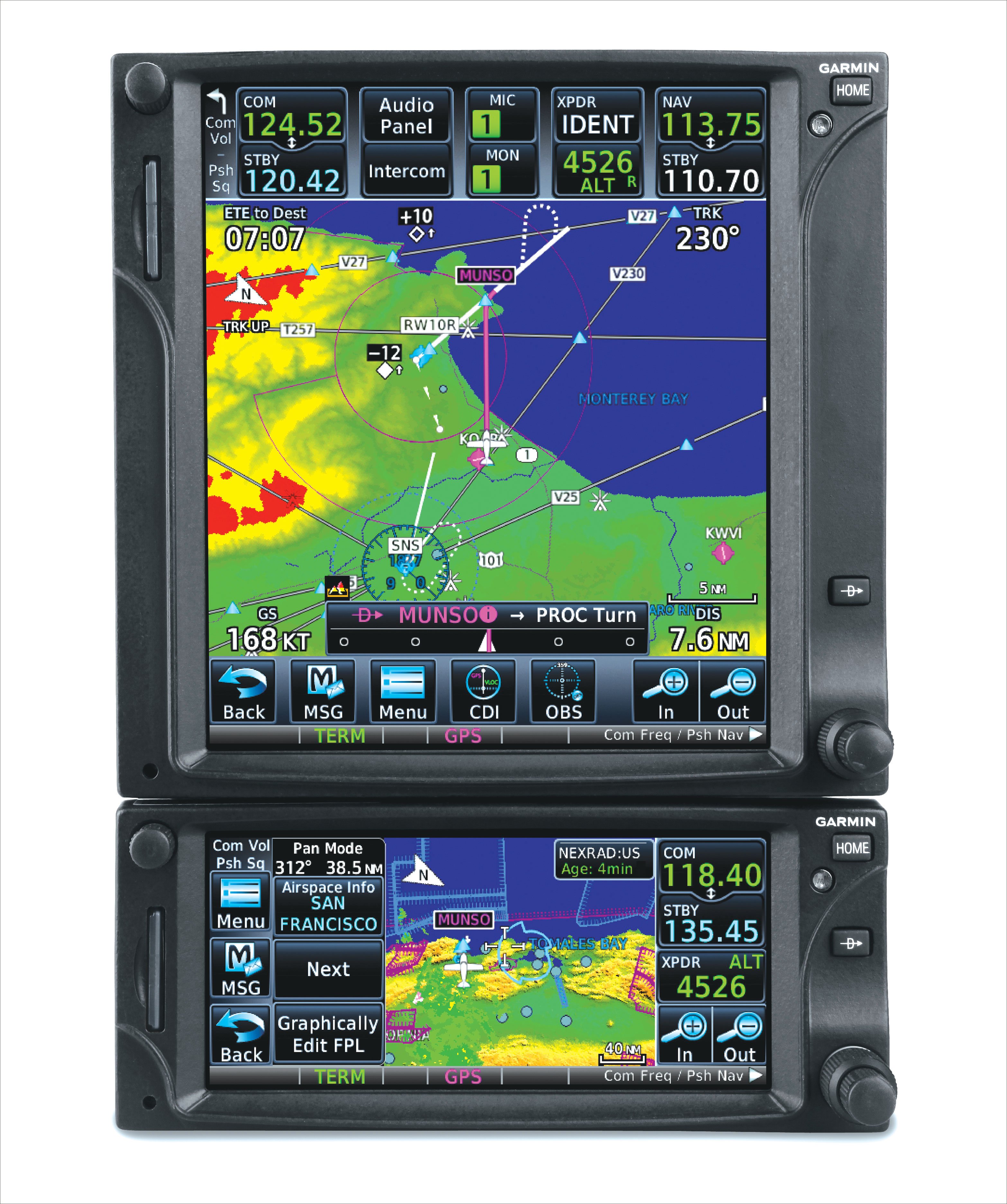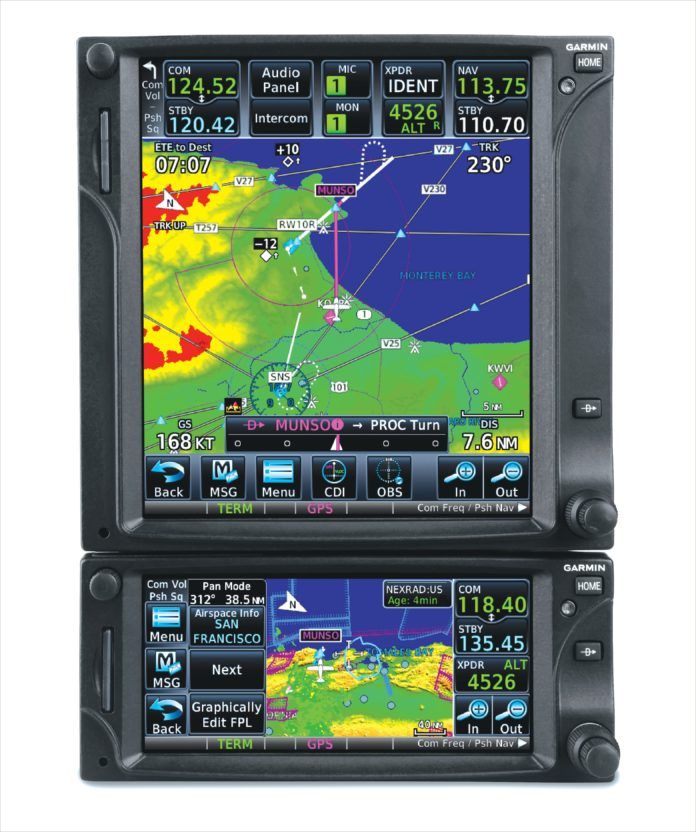For many, the cockpit weather product of choice is SiriusXM Satellite Weather (XMWX). That’s partly because of Garmin’s highly popular line of GPS portables with optional satellite XM receivers. That started with the GPSMAP 396 in 2002 and continues with the current aera series and GPSMAP 696. There’s also the GDL 69—an XMWX receiver compatible with most Garmin panel-mount devices. As dominant as Garmin and SiriusXM are in datalink weather, there are other choices.

Threatening the XMWX market is the growing popularity of portable and panel-mounted ADS-B receivers. The FAA’s FIS-B weather is a head-turner because, unlike subscription-based satellite options, it’s free.
In the last two months we covered XMWX and compared it to FIS-B. Now, we’ll sort through the hardware that’s required to get weather in the cockpit.
Trade-Up Trade-Offs
As explained in January, FIS-B (Flight Information System-Broadcast)—the FAA’s free, ground-based weather information stream—isn’t exactly a match for XMWX. Most FIS-B weather products are available in XMWX, but XMWX has far more weather offerings and expanded coverage (including Canada).
While XMWX is available anywhere in North America with a clear view of the satellite, the FAA’s FIS-B ground-based line-of-sight transmissions aren’t usually available until you’re airborne. Over much of the U.S., you’ll have coverage by 1800 feet AGL, but in some places it could be as high as 5000 feet AGL or higher. Further, FIS-B currently lacks terminal data, forecast icing and Echo Tops.
We mention this because making the switch to FIS-B—even if it means ditching the rising XM subscription fees—could limit your current weather-flying mission. Oh, and FIS-B won’t likely ever include music and entertainment.
Certified XMWX
Garmin was perhaps the first to offer a permanent-mount XMWX (and SIRIUS XM entertainment) solution, with the GDL 69-series.
The GDL 69 was a welcome improvement to its Echo Flight predecessor and provides WxWorx datalink products to a wide variety of Garmin panel-mount systems, from the MX20 MFD, the GNS 430 all the way to the G1000.
And that’s still the Garmin standard today—if you have nearly any Garmin device capable of displaying auxiliary information—the GDL 69 is your only choice for an approved (and recognized) built-in XMWX solution.
The GDL 69A is capable of delivering XM audio entertainment and datalink. (The “A” suffix means it’s entertainment capable.) The receiver mounts in a convenient location in the aircraft, but requires an external antenna. It is then cabled to the display or navigator.
For Avidyne and most other (non-Garmin) systems, Heads Up Technologies offers the XMD076. The XMD076A also delivers SiriusXM entertainment.
Avidyne’s MLB700 is a broadcast receiver that uses the SiriusXM satellite network to deliver weather content from WSI, not WxWorx. It’s available for use in the continental U.S. and southern Canada only. Like the XMD076A, the MLB700 interfaces with the entire line of Avidyne displays, and delivers SiriusXM entertainment.
The newer MLX770 is a two-way datalink system that uses the Iridium satellite network to provide WSI weather. The difference between it and the MLB700 is that the MLX770 works worldwide, thanks to Iridium.
On a side note, WSI delivers many of the same products as XMWX, including NOWRAD radar—which is similar to NEXRAD.
Aspen Avionics has an existing XMWX interface for its displays through the EWR50 XMWX receiver made by Heads Up Technologies. The EWR50 simultaneously provides datalink weather on up to three Evolution displays. You’ll need Aspen’s optional software to interface the EWR50—the same software that enables traffic overlay.
What about playing XMWX on your iPad? That’s an option with the Baron Mobile Link, an interface that uses a USB connection between the Mobile Link hardware and compatible weather receivers such as the Heads Up Technologies XMD075 (the portable version of the XMD076) and the WxWorx data receiver.


Panel ADS-B
From a technical standpoint, interfacing a panel-mounted ADS-B system isn’t much different than a satellite system. There’s a remote box and antenna, plus databus wires that feed the display.
Most owners who invest in a panel solution are also looking to satisfy the 2020 ADS-B Out mandate. This is where it gets complicated and requires an approved WAAS GPS position source. Garmin’s GTN 650/750 WAAS navigators fill that requirement, as will the GNS 430W/530W with the latest software. But you don’t need ADS-B Out to receive FIS-B weather. (You do if you want a reliable TIS-B traffic solution, but that’s another matter.)
Garmin’s GDL 88 is a full-up dual-link ADS-B system that receives and transmits on both 978 MHz (UAT) and 1090 MHz frequencies. The GDL 88 UAT is a one-box ADS-B solution, and available in several versions, including one with an integral WAAS GPS receiver that’s targeted at aircraft without a panel-mount GPS. (That receiver only provides position for ADS-B purposes; you won’t navigate with it.) While that sounds like an easy way to avoid an expensive WAAS GPS installation, there’s a trade-off. For those minimal interfaces, you’ll have to find a compatible display to play the weather on, since the GDL 88 won’t interface with a tablet or portable GPS. For FIS-B weather purposes, that’s a deal killer, unless you install Garmin’s GMX 200 MFD or a WAAS navigator.
If you have a compatible display, which is virtually any Garmin unit newer than (and including) a WAAS GNS navigator, the GDL 88 is an option that can provide ADS-B weather while also satisfying the 2020 ADS-B Out mandate.
A Sea of Portables
Choices for portable XMWX are limited to Garmin’s dedicated aviation portable GPSes and a receiver offered by WxWorx, the provider of the weather for XMWX.
The FAA’s original incentive of free weather to users investing in a full-up ADS-B system materialized, but you don’t need ADS-B output to get the free weather. Thanks to a handful of companies that jumped in to capitalize on the free ADS-B weather signal—including Garmin with their GDL 39 portable ADS-B receiver—playing FIS-B weather on your tablet has come full-circle.
Shopping the portable ADS-B market is enough to make your head spin, and we can’t come close to covering all of the options. (See the table for some common hardware-to-app choices.) The biggest challenge is pairing the ADS-B hardware to the tablet app that suits your preference—and ensuring the hardware is compatible with your selected app. Once you find a match, there may yet be some limitations or compatibility issues.
For instance, Garmin’s GDL 39 portable receiver works with a variety of Garmin portable GPS units, with some limitations in traffic function, while full weather and traffic functionality is achieved with Garmin’s Pilot application.
The Appareo Stratus-series portable ADS-B receiver sold by Sporty’s is married to the ForeFlight Mobile app. The Sagetech Clarity device works with Wing X Pro, but not with Foreflight Mobile, for example. Get the point?
No matter which portable FIS-B receiver you choose from among the many options, understand that you’ll need to mount it on the top of the glareshield for adequate reception. Whether it’s a Wi-Fi or Bluetooth connection with your tablet, the portable nature of these products means it’s another piece of hardware to manage in addition to the tablet. Some have built-in antennas while others require a separate antenna.
Many portable ADS-B receivers also include a GPS to provide position data to the tablet. As we explain in the sidebar, some units even have a built-in AHARS that allows them to display flight instruments on the tablet. We put those in the “glareshield candy” category because while they might not be worthy of totally reliable navigation in IMC, they offer no shortage of gee-whiz factor.


Compatibility
On a final note, if you’re concerned about long-term ADS-B solutions and how your current avionics suite will (or won’t) fit in, the Capstone Data Interface protocol may offer a glimmer of hope. This is an interface standard that was developed and proven for over a decade in the Capstone ADS-B program in Alaska.
The FAA published the standard in the hopes of promoting interoperability between different types and brands of ADS-B avionics and displays. In a nutshell, the standard defines technical requirements for RS-422/RS-232 data connections between cockpit displays and ADS-B datalink radios receiving traffic and weather broadcast services via DO-282B, DO-260B, DO-267A and DO-317 standards. It’s also referred to as the GDL 90 interface protocol, since Garmin/UPS-AT developed it and the GDL 90 ADS-B transceiver for Capstone. Garmin has since chosen not to adhere to the standard, instead adopting a proprietary interface protocol for the GDL 88 ADS-B transceiver.
Ultimately the Capstone protocol, says the FAA, is intended to ensure consistent and widespread access to ADS-B equipment. Reading between those lines, our hope is that it might provide flexibility when upgrading to ADS-B—a cross-brand compatibility of sorts—and without requiring major rework of existing equipment. Some compatibility exists, but each company also has their own products.
The Rangr series ADS-B units from FreeFlight Systems and Aspen’s yet-to-be-certified line of ARX100 and ATX200-series ADS-B receivers follow the Capstone protocol. Avidyne has also announced a commitment to the protocol, but hasn’t yet announced any products.
Finally, another interesting solution that might provide the most flexibility yet, is Aspen’s semi-portable Connected Weather CG50 Wi-Fi receiver. It provides certified connectivity between portable ADS-B receivers and Aspen displays. The CG50 is a small Wi-Fi device that hardwires into Evolution displays and allows you to simultaneously view ADS-B weather on an Evolution PFD or MFD—and via an iPad from the same portable source. That could offer the best of both worlds—tablet and panel-mounted connectivity—while offering a wide variety of weather receiver options.
Larry Anglisano, technophile, pilot, avionics technician, motorcyclist and bicyclist in Manchester, Connecticut, is editor of our sister publication, Aviation Consumer.
In addition to traffic, a deal-sweetener for some portable ADS-B weather systems is the addition of electronic flight instrumentation. We like to call these gadgets ‘glareshield candy’ because in general, we wouldn’t rely on them for take-to-the-bank reliability during a primary instrument failure in actual IMC. If you’ve used these gadgets you’ve probably discovered that the speed and altitude data is susceptible to lag and non-linear data display.



On the other hand, on a bad day it may be better than nothing, and for an additional crosscheck, they bring a certain level of utility. One portable system that tempts the boundaries of legality for certified aircraft is the $1395 iLevil AW. What’s unique about it is the ability to tap into the aircrafts pitot and static system, which adds actual pitot and static sensing for feeding the AHARS.
This means that instead of GPS-derived groundspeed, the iLevil can display indicated airspeed on Wing X Pro 7, Xavion and Levil’s AHRS utility. How good is it? Not quite good enough for sole means IFR, in our view. We evaluated it in the September 2013 issue of sister publication Aviation Consumer. While the airspeed data from the iLevil was linear, there were several dropouts that produced a red X on the display for a few seconds.
When it was working—which was most of the time—the iLevil AW data behaved like the airspeed indicator on any ADAHRS-driven EFIS. Its response is linear and free of the spikiness evident on tablet EFIS displays that rely on GPS groundspeed for an airspeed indication.
To read out indicated airspeed, you’ll need at least pitot reference pressure. The unit has an electrical connector for outputting serial data to feed non-certified panel mount equipment, and it will accept data input from the Zaon XRA portable traffic unit. (Zaon, by the way, went out of business while we were preparing this article.)
Although the AW is intended for experimental and LSA use, it could be possible to have it installed in a certified airplane that flies IFR. That’s the easy part. The hard part is finding a shop that is willing to sign off the pitot and static certification after they tap a non-certified portable into it. —LA





